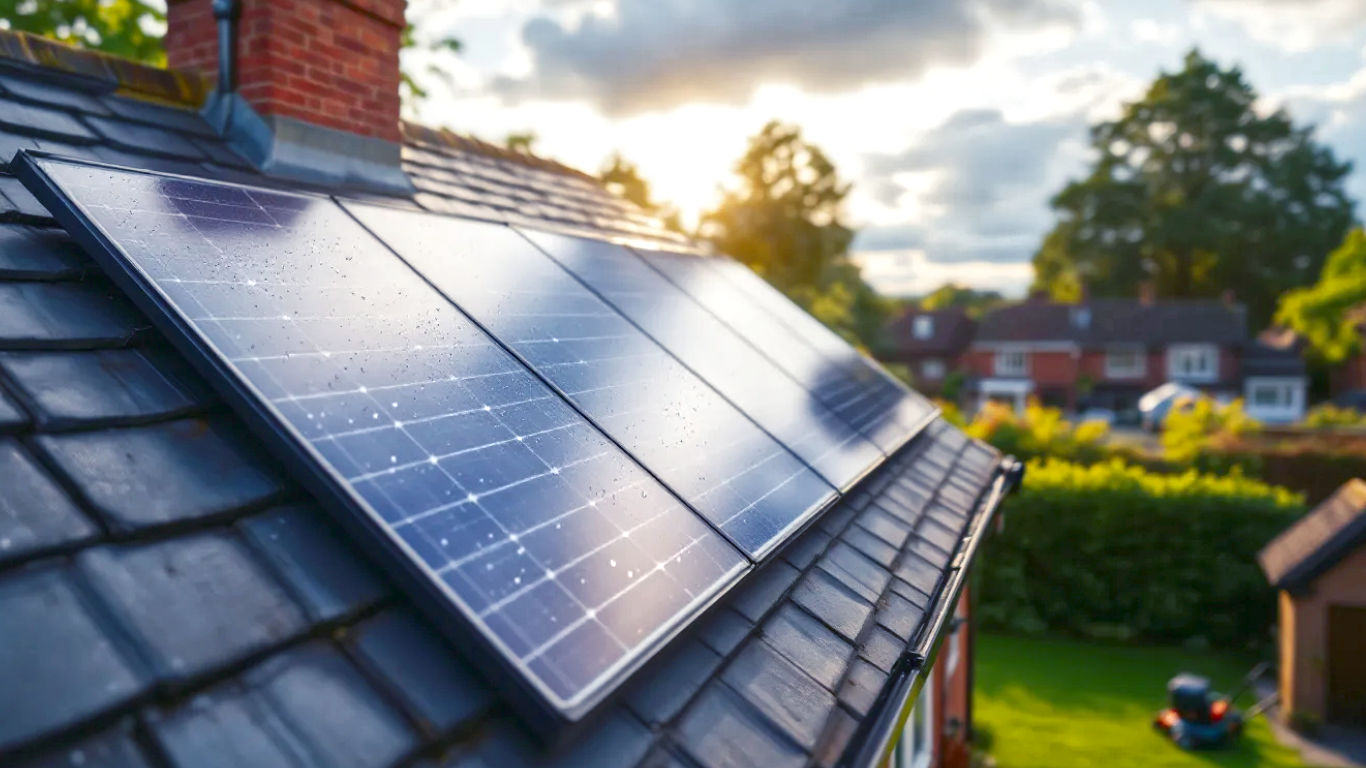How Do Solar Panels Work? From Sunshine to Your Socket
Our definitive guide explains exactly how solar panels work, from the silicon cells to the inverter, and how they generate clean electricity for your home.

This post may contain affiliate links. If you make a purchase through these links, we may earn a commission at no additional cost to you.
Ever looked up at the sun and wondered if we could just… plug into it? It’s a brilliant thought, and for millions of Brits, it’s already a reality. You’ve probably seen them: sleek, dark rectangles glinting on rooftops from Aberdeen to Brighton. They’re solar panels, and they’re quietly turning ordinary British sunshine (yes, even the cloudy kind) into the electricity that powers our kettles, tellies, and everything in between.
But how exactly do they do it? Is it some kind of space-age magic? Not quite, but the science behind it is genuinely fascinating. It’s a story that involves clever physics, tiny particles of light, and a journey from a rooftop panel right down to the plug socket in your wall.
In this guide, we’re going to unravel the whole process. We’ll look at what solar panels are made of, how they capture sunlight, and the clever trick they use to convert it into usable electricity for your home. We’ll explore the different bits of kit you need, find out if they work on those famously grey British days, and look at what the future holds for solar power. Forget the complicated jargon; we’re going to break it down, step-by-step. Let’s get started.
What’s Actually Inside a Solar Panel? The Building Blocks of Solar Power
At first glance, a solar panel looks like a simple sheet of dark glass in a metal frame. But inside that neat package is some seriously clever technology. The magic happens in the solar cells, which are the small, usually square-shaped units that make up the larger panel.
Think of a solar panel as a big chocolate bar, where each square of chocolate is a solar cell. Hundreds of these cells are wired together to create one panel, and often several panels are linked up to form a ‘solar array’ on a roof.
The Special Ingredient: Silicon
The star player inside almost every solar cell is an element called silicon. You might not have heard of it, but it’s the second most common element on Earth (after oxygen) and is found in sand and rock. It’s the same stuff used to make computer chips, which gives you a clue that it’s pretty special.
But you can’t just use any old silicon. To make a solar cell, you need it to be incredibly pure. This silicon is melted down at scorching temperatures and grown into large crystals, which are then sliced into ultra-thin wafers. These wafers are thinner than a sheet of paper and are the foundation of the solar cell.
Creating the ‘Electric Field’ Sandwich
This is where the real cleverness begins. A solar cell isn’t just a plain slice of silicon. It’s more like a sandwich made of two slightly different types of silicon.
- The N-type Layer: The top layer of the silicon wafer is mixed with a tiny amount of phosphorus. Phosphorus has one more electron than silicon, so this layer now has a surplus of electrons. Because electrons have a negative charge, this is called the n-type (for negative) silicon.
- The P-type Layer: The bottom layer is mixed with a different element, usually boron. Boron has one fewer electron than silicon. This creates little “holes” where electrons should be, giving this layer a positive charge. This is called the p-type (for positive) silicon.
When you press these two layers together, something amazing happens at the boundary where they meet, called the p-n junction. The extra electrons from the n-type layer jump over to fill the holes in the p-type layer. This movement of electrons creates a permanent electric field across the junction.
Imagine a playground slide. The electric field is like that slide. It doesn’t do anything on its own, but it creates a one-way path. Once an electron is at the top, it can only slide down to the bottom. This built-in, one-way street for electrons is the absolute key to how a solar panel works.
So, to recap, inside every solar panel, you have:
- Hundreds of solar cells, each made from silicon wafers.
- Each cell is a “sandwich” of n-type and p-type silicon.
- This creates a permanent electric field at the p-n junction.
With this special sandwich all set up, the solar cell is now ready and waiting for its fuel: sunlight.
The Photovoltaic Effect: Turning Sunshine into a Spark
Now we get to the heart of the matter. How does that silicon sandwich actually make electricity when the sun shines on it? It all comes down to a process with a fancy name: the photovoltaic effect.
Let’s break that word down. ‘Photo’ comes from the Greek word for light. ‘Voltaic’ relates to electricity, named after Alessandro Volta, an Italian physicist who invented the first battery. So, ‘photovoltaic’ literally means ‘light-electricity’. It’s the process of making electricity directly from light.
Little Packets of Energy: Meet the Photon
Sunlight might look like a steady, continuous stream of light, but it’s actually made up of billions upon billions of tiny energy packets called photons. These photons shoot out from the sun, travel 93 million miles through space, and rain down on your rooftop solar panel every single second of the day.
When one of these photons hits the silicon solar cell, its journey ends in a tiny collision. And that’s when the magic happens.
The Knock-On Effect: How a Photon Creates a Current
Remember that electric field—the one-way slide we talked about? It’s sitting there, waiting.
- A Photon Strikes: A photon from the sun hits the silicon cell with enough energy to knock an electron loose from its atom. This creates a free electron and leaves behind a “hole”.
- The Electric Field Steps In: As soon as the electron is knocked free, the electric field at the p-n junction springs into action. Because of its one-way nature, it pushes the negatively charged electron towards the n-type side (the top) and pushes the positively charged hole towards the p-type side (the bottom).
- Separation is Key: This separation is crucial. Without the electric field, the electron would just find another hole and fall back into place, and nothing would happen. But the field keeps them apart, creating a difference in charge between the top and bottom of the cell. The top surface now has a build-up of electrons (negative charge), and the bottom has a build-up of holes (positive charge).
This difference in charge is exactly what a battery has. Your solar cell has effectively become a tiny, sun-powered battery!
From a Trickle to a Flood: Creating a Usable Current
A single solar cell doesn’t produce much electricity—only about half a volt. That’s not enough to even charge your phone, let alone boil a kettle.
This is why solar panels are made of many cells wired together. Thin metal strips, called busbars, are printed onto the surface of the cells. They act like tiny wires, collecting the freed electrons from each cell.
- The electrons flow from the n-type layer, up through the busbars.
- They travel through all the cells connected in the panel.
- This flow of electrons is what we call an electric current.
By linking all these cells together, the panel can generate a much more useful amount of electricity. And by linking several panels together in an array, you can generate enough power for your entire home.
The electricity created by this process is a specific type called Direct Current (DC). This is the same type of power you get from batteries. However, our homes and the UK’s National Grid run on a different type of electricity called Alternating Current (AC). So, there’s one more crucial step in the journey.
The Full Solar Setup: From Panel to Plug
Generating DC electricity on your roof is a brilliant start, but it’s not much use if you can’t power your appliances with it. To get the solar energy from your panels into a usable form, you need a few more pieces of kit. Together, they make up a complete solar PV (photovoltaic) system.
The Inverter: The Brains of the Operation
The most important component after the panels themselves is the inverter. If the solar panels are the heart of the system, the inverter is the brain. Its main job is to convert the Direct Current (DC) electricity produced by the panels into Alternating Current (AC) electricity that your home can use.
Imagine DC electricity as a car driving steadily in one direction down a motorway. AC electricity is more like a car shuffling forwards and backwards very quickly. All the appliances in your home, from your washing machine to your TV, are designed to run on this AC “shuffling” power. The inverter makes that crucial switch.
There are a few different types of inverters:
- String Inverters: This is the most common and traditional type. All your solar panels are connected together in a series (a ‘string’), and they all feed into one single inverter, which is usually installed in your loft or garage. It’s a reliable and cost-effective solution, but it has one drawback: if one panel is shaded or dirty, it can reduce the performance of the entire string, a bit like how one faulty bulb can make a whole string of fairy lights go out.
- Microinverters: Instead of one big inverter, a microinverter system attaches a small inverter to the back of every single panel. Each panel’s DC power is converted to AC right there on the roof. This is great because if one panel is underperforming, it doesn’t affect the others at all. They are more expensive but are fantastic for roofs that have patches of shade from chimneys or nearby trees.
- Power Optimisers: This is a clever hybrid solution. Like microinverters, a small device called an optimiser is attached to each panel. These optimisers ‘condition’ the DC electricity from each panel before sending it down to a single string inverter. This setup allows you to monitor the performance of each panel individually and mitigates the effect of shading, offering a good balance between cost and performance.
The Journey of Solar Electricity
So, let’s trace the path of the energy on a sunny day:
- Sunlight hits the panels: Photons knock electrons loose in the silicon cells, creating DC electricity.
- Panels to the inverter: The DC electricity flows through cables down from the roof to the inverter.
- Inverter does its job: The inverter converts the DC electricity into AC electricity.
- Powering your home: From the inverter, the AC electricity flows to your fuse box (also called a consumer unit). From there, it travels through your home’s wiring to your sockets and appliances.
Your home will automatically use the free solar electricity first before drawing any power from the National Grid. If your panels are producing more electricity than you’re using, the extra power has to go somewhere. This is where things get even smarter.
What Happens to the Extra Energy? Selling Back to the Grid
On a bright summer afternoon, a typical home solar system might be generating 3 kilowatts (kW) of power, but the house might only be using 0.5 kW to run the fridge and other background devices. The leftover 2.5 kW is surplus energy.
Thanks to the UK’s Smart Export Guarantee (SEG) scheme, you can sell this surplus electricity back to the grid. Your smart meter keeps track of how much you export, and your chosen energy supplier pays you for every unit you send their way. It’s not a huge amount of money, but it’s a great way to get paid for the clean energy you’re generating.
Alternatively, you can store this extra energy for later using a solar battery.
Solar Batteries: Storing Sunshine for a Rainy Day
A solar battery is a game-changer for home energy. It’s a large, rechargeable battery (usually installed in a garage or utility room) that stores the excess solar energy your panels generate during the day.
Instead of exporting your surplus power to the grid for a few pence, you can save it in your battery. Then, in the evening when the sun has gone down and your panels aren’t generating, you can power your home with your own stored, free, green electricity instead of buying it from the grid at a higher price. This massively increases your energy self-sufficiency and can save you a lot more money in the long run.
Common Questions: Solar Panels and the Great British Weather
Let’s be honest, the UK isn’t exactly famous for its year-round sunshine. This leads to the most common question of all: do solar panels actually work in Britain?
The short answer is: yes, absolutely.
Do Solar Panels Need Direct, Hot Sunshine?
This is a big misconception. Solar panels work on light, not heat. They can and do generate electricity even on cool, cloudy, or overcast days. In fact, solar panels can be more efficient in cooler temperatures. If they get too hot, their performance can slightly decrease. Germany, a country not known for its tropical climate, is one of the world leaders in solar power, which proves you don’t need a Mediterranean climate.
Of course, a solar panel will produce more electricity on a clear, sunny day than on a gloomy, overcast one. The output will vary depending on the time of day, the season, and the amount of cloud cover. But even on a cloudy winter day, they will still be generating some power.
Think of it like this: on a cloudy day, you can still get sunburned. That’s because UV light is still getting through the clouds. In the same way, photons are still getting through and hitting your panels, just fewer of them.
How Much Electricity Can I Expect in the UK?
The amount of power a solar system generates is measured in kilowatt-hours (kWh). A typical 4 kWp system (the ‘p’ stands for ‘peak’, its maximum potential output) in the UK will generate around 3,400 kWh of electricity per year. The average UK household uses about 2,700 kWh of electricity annually, so a standard system can easily cover a significant portion of a home’s needs.
Your output will be highest in the summer months (from May to August) when the days are long and the sun is high in the sky. It will be lowest in the winter (from November to January).
Do They Need Cleaning and Maintenance?
Solar panels are remarkably low-maintenance. They are built to withstand the elements—rain, wind, hail, and snow—for 25 years or more.
Rainwater does a pretty good job of washing away most of the dust and grime that might accumulate. In most parts of the UK, you might only need to have them professionally cleaned every couple of years. However, if you live in a particularly dusty area, near a busy road, or have a problem with bird droppings, you might need to clean them more often. It’s important to do this safely; hiring a professional is often the best bet.
Beyond that, a good installer will offer an annual health check to make sure the inverter is working correctly and all the connections are secure. But for the most part, you can just sit back and let them do their thing.
The Bigger Picture: Solar Power’s History and Its Role in the UK
Solar power feels like a modern invention, but the science behind it has been around for a very long time.
A Quick Trip Through Solar History
- 1839: A young French physicist named Edmond Becquerel first discovered the photovoltaic effect. While experimenting with metal electrodes in a conductive solution, he noticed that shining light on them produced a small electric current. He was only 19!
- 1883: American inventor Charles Fritts created the very first solid-state solar cell. He coated selenium with a thin layer of gold. His cells were less than 1% efficient, meaning they converted less than 1% of the sunlight hitting them into electricity. They were too inefficient to be useful for power, but they were used as light sensors.
- 1954: The breakthrough moment. At Bell Labs in the United States, three researchers—Daryl Chapin, Calvin Fuller, and Gerald Pearson—created the first practical silicon solar cell. It achieved an efficiency of around 6%, which was a huge leap forward. They initially demonstrated it by powering a small toy windmill and a radio transmitter. This is widely seen as the birth of modern solar technology.
- 1950s & 60s: Early solar panels were incredibly expensive to produce. Their first major use was in space exploration. Satellites needed a way to power themselves for long periods, and solar panels were the perfect solution. The Vanguard 1 satellite, launched in 1958, was the first to use them.
- 1970s: The oil crisis of the 1970s sparked a huge interest in alternative energy sources. Governments and researchers started investing seriously in making solar power cheaper and more efficient.
- 2000s – Present: In the last two decades, the cost of solar panels has plummeted while their efficiency has soared. Thanks to mass production, technological improvements, and government incentives, solar power has transformed from a niche technology into one of the world’s cheapest and fastest-growing sources of electricity.
Solar Power in the UK Today
The UK has embraced solar power in a big way. What started with a few pioneering homes has grown into a major part of our national energy mix.
- Homes and Businesses: Over a million homes in the UK now have solar panels installed. They are helping households cut their electricity bills, reduce their carbon footprint, and gain more energy independence.
- Solar Farms: It’s not just on rooftops. You’ve probably seen large fields filled with rows upon rows of solar panels. These are solar farms, and they generate electricity on a massive scale, feeding it directly into the National Grid. The UK has hundreds of them, from a huge farm at a former RAF base in Wales to one powering a hospital in London.
- Renewable Energy Goals: Solar power is a cornerstone of the UK’s strategy to move away from fossil fuels and achieve its net-zero emissions target by 2050. On sunny days, solar power can provide up to a quarter of the country’s entire electricity demand. In May 2020, for the first time ever, more of Britain’s electricity came from the sun than from coal over a whole month.
The Future of Solar: What’s Next?
The technology behind solar panels is not standing still. Scientists and engineers around the world are constantly working on ways to make them even better, cheaper, and more versatile. Here’s a glimpse of what’s on the horizon.
Higher Efficiency Panels
The race is on to squeeze more electricity out of every ray of sunshine. While standard silicon panels today are around 20% efficient, new technologies are pushing that number much higher.
- PERC Cells (Passivated Emitter and Rear Cell): This is an advancement on the standard cell design. A special layer is added to the back of the cell, which reflects light back into the silicon, giving it a second chance to be absorbed and generate an electron. This is already a common technology in high-quality modern panels.
- Tandem Solar Cells: These are like a double-decker solar cell. They stack two different types of solar-absorbing materials on top of each other. Each layer is designed to capture a different part of the light spectrum. The top layer might capture blue light, while the bottom layer captures red light. By working together, they can achieve efficiencies of over 30%. Researchers at the University of Oxford are at the forefront of developing this technology using a material called perovskite.
Solar Technology That Blends In
In the future, you might not even be able to see the solar panels around you. Researchers are developing innovative ways to integrate solar technology directly into the materials we use every day.
- Solar Tiles: Companies are already producing roof tiles that look just like traditional slate or terracotta tiles but have solar cells embedded within them. This offers a much more discreet look for homes in conservation areas or for people who don’t like the appearance of traditional panels.
- Transparent Solar Cells (Solar Windows): Imagine if every window in an office block could generate electricity. Scientists are developing transparent solar cells that can be applied to glass without blocking the view. They only capture the invisible parts of the light spectrum (ultraviolet and infrared), letting visible light pass through.
- Solar Fabrics: Flexible, lightweight solar cells could be woven into fabrics to create clothes that can charge your devices or tents that can power your campsite.
A Smarter, Greener Grid
As more and more homes generate their own power with solar panels and batteries, our entire energy system is changing. We are moving from a centralised system with a few large power stations to a decentralised one with millions of small generators.
This opens the door to a “smart grid” where homes can not only buy and sell electricity but also help to balance the grid. For example, a network of homes with solar batteries could be asked to release their stored energy during peak demand to prevent blackouts, and get paid for doing so.
Solar power is more than just a clever way to cut your electricity bill. It’s a fundamental part of the UK’s clean energy future. The simple, silent process happening inside those panels on your neighbour’s roof—photons knocking electrons loose to create a current—is helping to power our country in a cleaner, greener, and more sustainable way. From a curious teenager’s discovery in 19th-century France to the solar farms powering our nation today, the journey of the solar panel is a truly bright one.
Further Reading
For those interested in exploring the topic in greater detail, here are some highly respected resources:
- Energy Saving Trust: An independent organisation providing impartial advice on how to save energy. Their section on solar panels is an excellent resource for UK homeowners. https://energysavingtrust.org.uk/advice/solar-panels/
- Ofgem (The Office of Gas and Electricity Markets): The UK’s energy regulator. They provide official information on government schemes like the Smart Export Guarantee (SEG). https://www.ofgem.gov.uk/environmental-and-social-schemes/smart-export-guarantee-seg
- Microgeneration Certification Scheme (MCS): The standards organisation for renewable energy installers and products in the UK. Their website is a good place to find certified installers and learn about the standards products must meet. https://mcscertified.com/
- National Grid ESO: Find out how much of Great Britain’s electricity is being generated by solar power in real-time. https://grid.iamkate.com/






